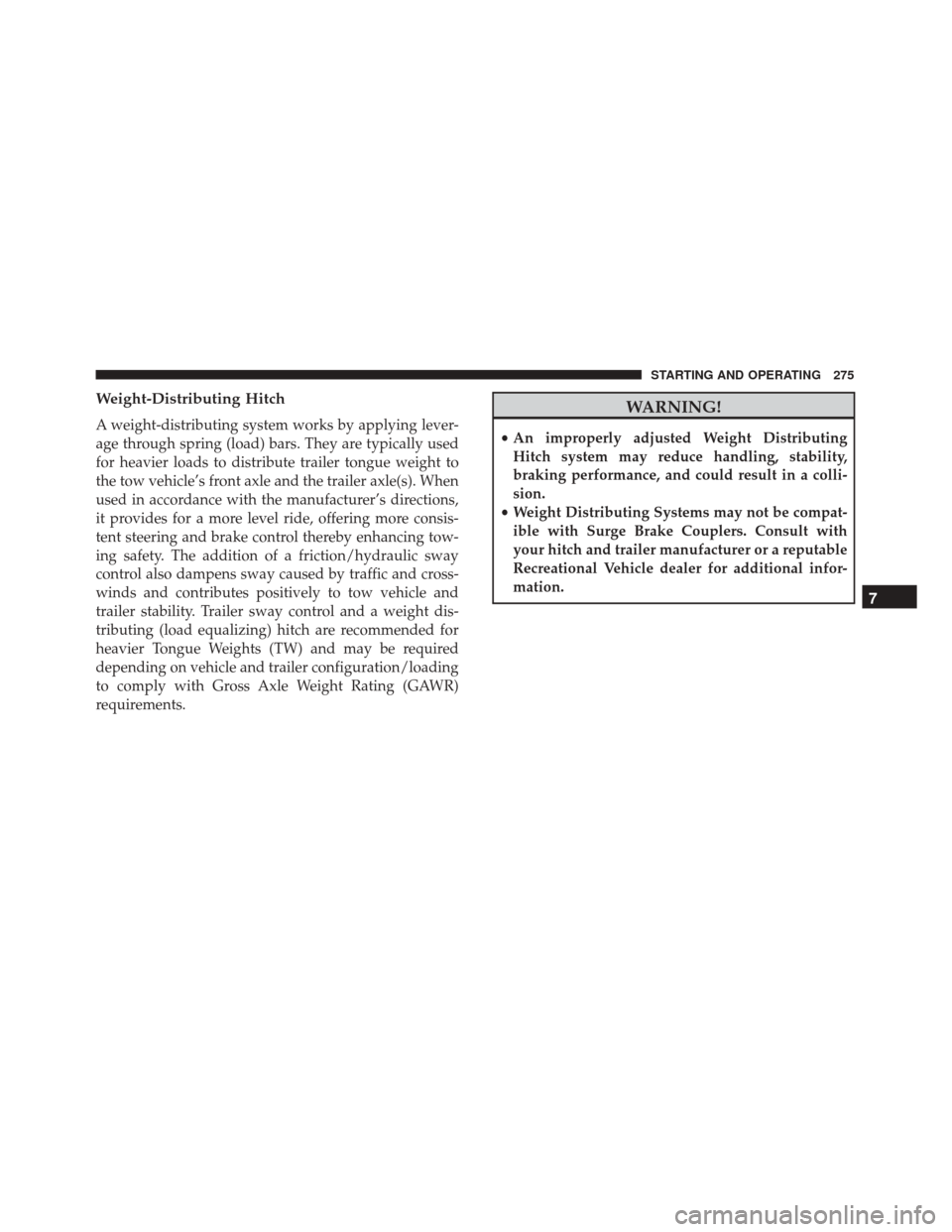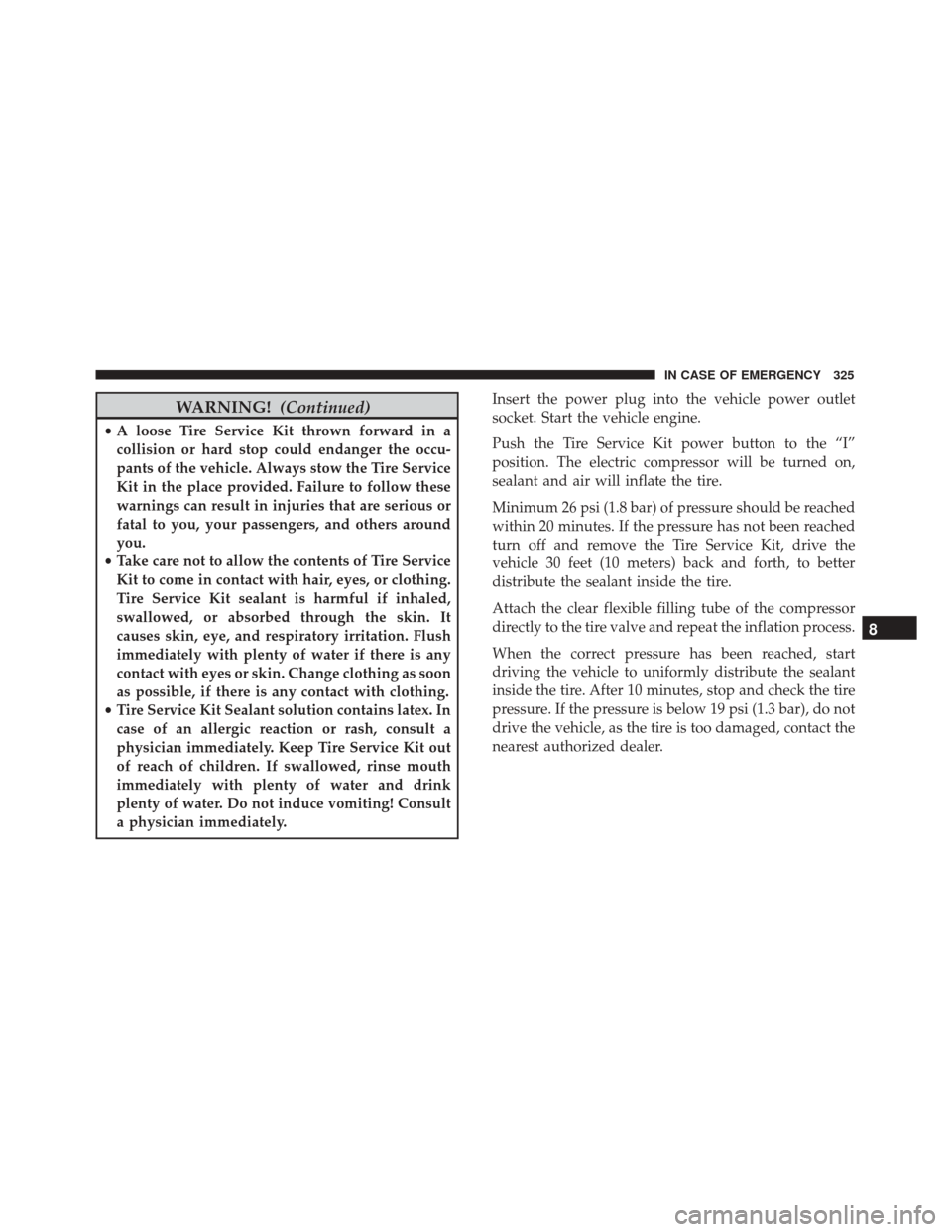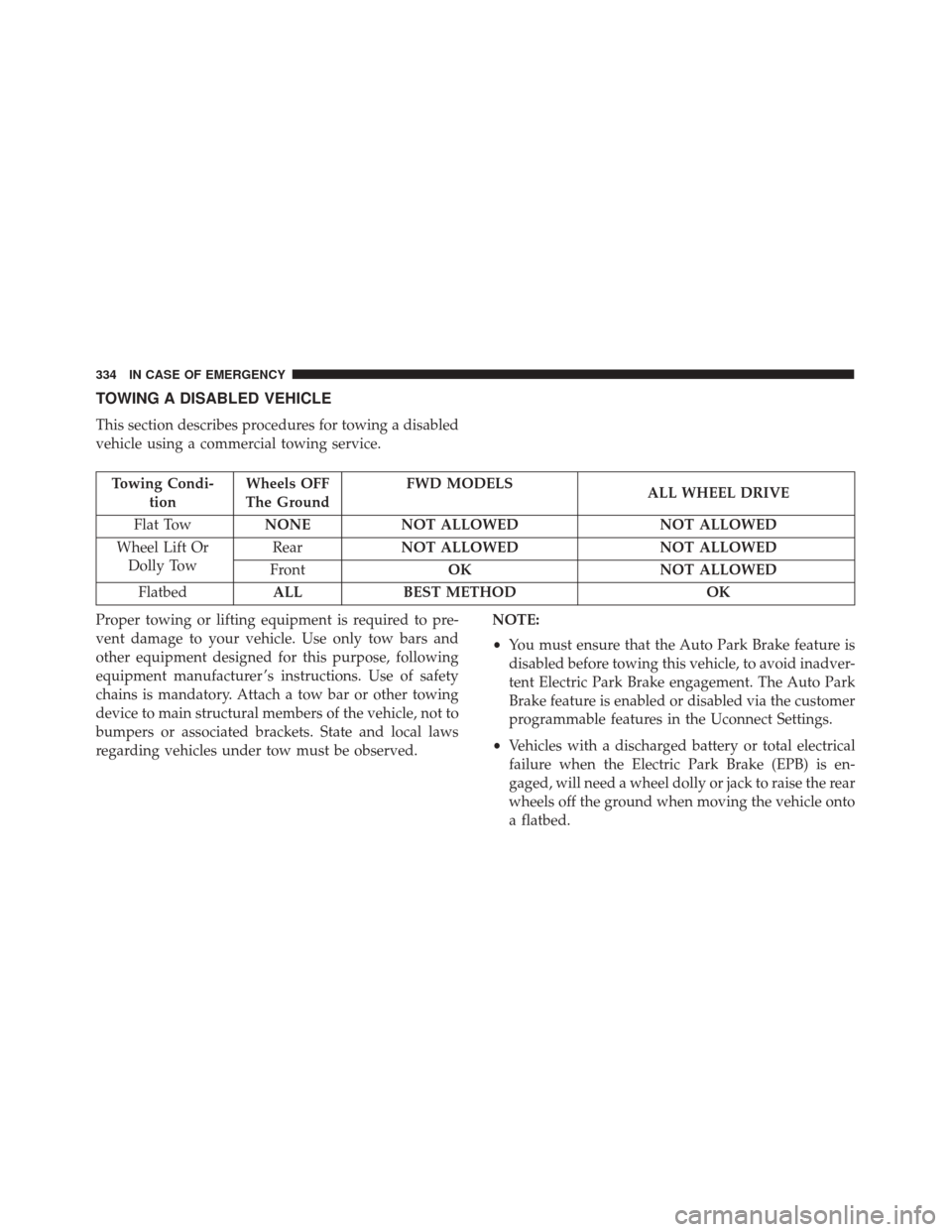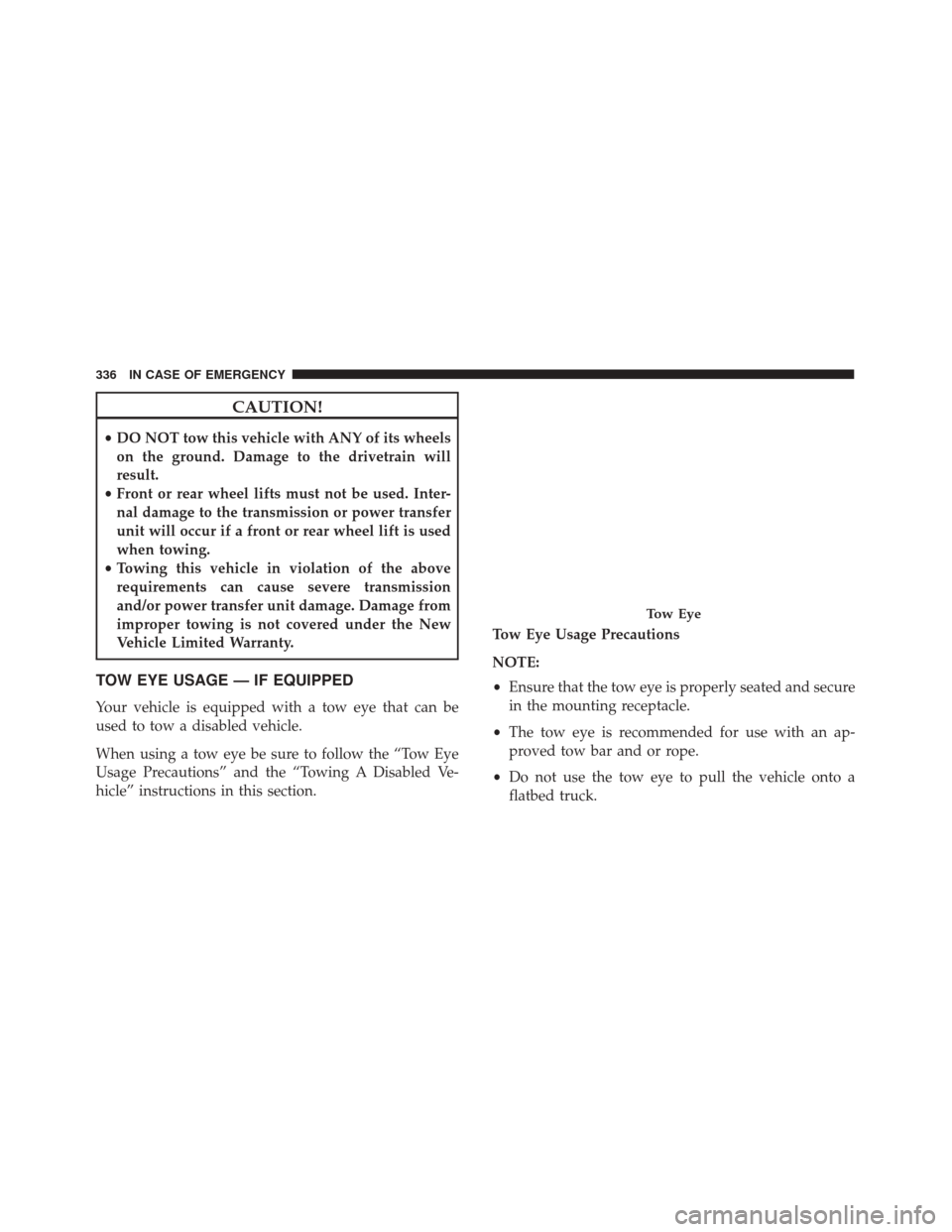Page 277 of 476

Weight-Distributing Hitch
A weight-distributing system works by applying lever-
age through spring (load) bars. They are typically used
for heavier loads to distribute trailer tongue weight to
the tow vehicle’s front axle and the trailer axle(s). When
used in accordance with the manufacturer’s directions,
it provides for a more level ride, offering more consis-
tent steering and brake control thereby enhancing tow-
ing safety. The addition of a friction/hydraulic sway
control also dampens sway caused by traffic and cross-
winds and contributes positively to tow vehicle and
trailer stability. Trailer sway control and a weight dis-
tributing (load equalizing) hitch are recommended for
heavier Tongue Weights (TW) and may be required
depending on vehicle and trailer configuration/loading
to comply with Gross Axle Weight Rating (GAWR)
requirements.
WARNING!
•An improperly adjusted Weight Distributing
Hitch system may reduce handling, stability,
braking performance, and could result in a colli-
sion.
• Weight Distributing Systems may not be compat-
ible with Surge Brake Couplers. Consult with
your hitch and trailer manufacturer or a reputable
Recreational Vehicle dealer for additional infor-
mation.
7
STARTING AND OPERATING 275
Page 327 of 476

WARNING!(Continued)
•A loose Tire Service Kit thrown forward in a
collision or hard stop could endanger the occu-
pants of the vehicle. Always stow the Tire Service
Kit in the place provided. Failure to follow these
warnings can result in injuries that are serious or
fatal to you, your passengers, and others around
you.
• Take care not to allow the contents of Tire Service
Kit to come in contact with hair, eyes, or clothing.
Tire Service Kit sealant is harmful if inhaled,
swallowed, or absorbed through the skin. It
causes skin, eye, and respiratory irritation. Flush
immediately with plenty of water if there is any
contact with eyes or skin. Change clothing as soon
as possible, if there is any contact with clothing.
• Tire Service Kit Sealant solution contains latex. In
case of an allergic reaction or rash, consult a
physician immediately. Keep Tire Service Kit out
of reach of children. If swallowed, rinse mouth
immediately with plenty of water and drink
plenty of water. Do not induce vomiting! Consult
a physician immediately. Insert the power plug into the vehicle power outlet
socket. Start the vehicle engine.
Push the Tire Service Kit power button to the “I”
position. The electric compressor will be turned on,
sealant and air will inflate the tire.
Minimum 26 psi (1.8 bar) of pressure should be reached
within 20 minutes. If the pressure has not been reached
turn off and remove the Tire Service Kit, drive the
vehicle 30 feet (10 meters) back and forth, to better
distribute the sealant inside the tire.
Attach the clear flexible filling tube of the compressor
directly to the tire valve and repeat the inflation process.
When the correct pressure has been reached, start
driving the vehicle to uniformly distribute the sealant
inside the tire. After 10 minutes, stop and check the tire
pressure. If the pressure is below 19 psi (1.3 bar), do not
drive the vehicle, as the tire is too damaged, contact the
nearest authorized dealer.
8
IN CASE OF EMERGENCY 325
Page 336 of 476

TOWING A DISABLED VEHICLE
This section describes procedures for towing a disabled
vehicle using a commercial towing service.
Towing Condi-tion Wheels OFF
The Ground FWD MODELS
ALL WHEEL DRIVE
Flat Tow NONE NOT ALLOWED NOT ALLOWED
Wheel Lift Or Dolly Tow Rear
NOT ALLOWED NOT ALLOWED
Front OK NOT ALLOWED
Flatbed ALLBEST METHOD OK
Proper towing or lifting equipment is required to pre-
vent damage to your vehicle. Use only tow bars and
other equipment designed for this purpose, following
equipment manufacturer ’s instructions. Use of safety
chains is mandatory. Attach a tow bar or other towing
device to main structural members of the vehicle, not to
bumpers or associated brackets. State and local laws
regarding vehicles under tow must be observed. NOTE:
•
You must ensure that the Auto Park Brake feature is
disabled before towing this vehicle, to avoid inadver-
tent Electric Park Brake engagement. The Auto Park
Brake feature is enabled or disabled via the customer
programmable features in the Uconnect Settings.
• Vehicles with a discharged battery or total electrical
failure when the Electric Park Brake (EPB) is en-
gaged, will need a wheel dolly or jack to raise the rear
wheels off the ground when moving the vehicle onto
a flatbed.
334 IN CASE OF EMERGENCY
Page 338 of 476

CAUTION!
•DO NOT tow this vehicle with ANY of its wheels
on the ground. Damage to the drivetrain will
result.
• Front or rear wheel lifts must not be used. Inter-
nal damage to the transmission or power transfer
unit will occur if a front or rear wheel lift is used
when towing.
• Towing this vehicle in violation of the above
requirements can cause severe transmission
and/or power transfer unit damage. Damage from
improper towing is not covered under the New
Vehicle Limited Warranty.
TOW EYE USAGE — IF EQUIPPED
Your vehicle is equipped with a tow eye that can be
used to tow a disabled vehicle.
When using a tow eye be sure to follow the “Tow Eye
Usage Precautions” and the “Towing A Disabled Ve-
hicle” instructions in this section. Tow Eye Usage Precautions
NOTE:
•
Ensure that the tow eye is properly seated and secure
in the mounting receptacle.
• The tow eye is recommended for use with an ap-
proved tow bar and or rope.
• Do not use the tow eye to pull the vehicle onto a
flatbed truck.
Tow Eye
336 IN CASE OF EMERGENCY
Page 339 of 476
•Do not use the tow eye to free a stuck vehicle. Refer
to “Freeing A Stuck Vehicle” in this section for further
information.
WARNING!
Stand clear of vehicles when pulling with tow eyes.
• Do not use a chain with a tow eye. Chains may
break, causing serious injury or death.
• Do not use a tow strap with a tow eye. Tow straps
may break or become disengaged, causing serious
injury or death.
• Failure to follow proper tow eye usage may cause
components to break resulting in serious injury
or death.
CAUTION!
• The tow eye must be used exclusively for road-
side assistance operations. Only use the tow eye
with an appropriate device in accordance with the
highway code (a rigid bar or rope) to flat tow the
vehicle for a short distance to the nearest service
location.
• Tow eyes MUST NOT be used to tow vehicles off
the road or where there are obstacles.
(Continued)
Tow Eye Warning Label
8
IN CASE OF EMERGENCY 337